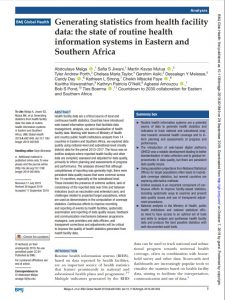
Routine health information systems (RHIS), based on data reported by health facilities, are an important source of health statistics that feature prominently in national and subnational health plans and program. Multiple indicators generated by the RHIS data can be used to track national and subnational progress towards universal health coverage, often in combination with household survey and other data. Scorecards and dashboards are increasingly popular tools to visualize the statistics based on health facility data, aiming to facilitate the interpretation, communication and use of data.
Countries and development partners have been investing in the improvement of the data generation and use through the RHIS. A notable development is the introduction of the District Health Information System (DHIS), which is an open-source software platform for reporting, quality checks, visualization, analysis and dissemination of data for all health program. From 2010 onwards, an increasing number of countries began to introduce the web-based DHIS2 platform, and today many countries are using this electronic platform.
Common RHIS data-based indicators include causes of death and morbidity patterns among persons using health services, health service utilization and efficiency indicators, as well as a range of program-specific indicators on the coverage of interventions. Several programs such as immunization and HIV have been relying extensively on facility data-based coverage statistics for country and global monitoring.
Studies have shown multiple issues regarding the quality of data generated by health facilities that affect the credibility and utility of RHIS-based statistics at local and national levels. The main challenges are associated with incomplete and inaccurate reporting of events, as well as problems with defining accurate denominators (ie, target populations) for the computation of coverage statistics.
This paper describes the situation in 14 countries in Eastern and Southern Africa in 2017, based on an analysis project involving teams of Ministry of Health and country public health institutions analysts, organized by the African Population Health Research Centre, Countdown to 2030 for Women’s, Children’s and Adolescents’ Health, WHO and UNICEF. The focus was on ‘endline’ analysis where all relevant health facility data are compiled and systematically assessed, including assessment and adjustment for incomplete reporting, detection and correction of extreme outliers, assessment and revision of denominators, comparison with survey-based results and computation of statistics based on the adjusted data set. These analyses were done in MS Excel 2013, using data exported from the DHIS2 country databases.